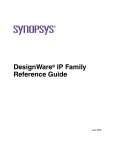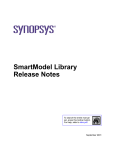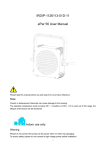Download Verification Intellectual Property (IP) Modeling Architecture
Transcript
Verification Intellectual Property (IP) Modeling Architecture Guide to Structured Development Using OpenVera May 2002 Version 1.1 Verification IP Modeling Architecture version 1.1 Authors: Mehdi Mohtashemi Azita Mofidian Verification Technology Group, Synopsys, Inc. http://www.smartverification.com/ http://www.synopsys.com/products/hlv/hlv.html http://www.open-vera.com/ Revision History Version 1.1 Date May 2002 Description First release on open-vera.com page. Copyright and Release information: Vera, OpenVera, and OpenVera Assertion (OVA) are trademark of Synopsys, Inc. All usage is governed by legal agreements. With proper credit, referencing and usage of the concept is permitted. Send correspondence and clarifications to: [email protected] © Synopsys, Inc. 2001-2002 May 2002 Page 2 of 32 Verification IP Modeling Architecture version 1.1 Abstract The ever increasing advances in the integrated circuit technology during the past decade has made it possible for electronic system designers to assemble complete systems-on-chips (SoC). As these System on chips have found their use in more and more computer, graphics, and networking hardware systems the level and complexity of functionality within them have dramatically increased. At the same time shrinking time to market leaves little room for errors in the design. Hence functional verification has become one of the major tasks in committing chips to fabrication. Just as designs are pushing more towards reusable and portable environment so must the verification components and environment. Also, more technologically advanced and high-pin packages allow each chip to have multiple bus interfaces, each of which may share internal resources in parallel and increase the possible concurrent operations. Therefore there has arisen a real and pressing need in the electronic design process for standalone, pre-verified and built-in verification infrastructure, which can be easily plugged in the simulation-based validation tests. The Verification Intellectual Property (Verification IP) is an integral and important component of such infrastructure and provides such mechanisms. In this technical document we present a foundation of a modeling architecture for the structured development of such verification components. The architecture is based on the concept of layered methodology, which can be applied to general abstract and advanced testbench development for ASICS and SoC and systems. In this paper the psuedo-code examples based on OpenVera Hardware Verification Language are provided to show the fundamentals of the modeling methodology. In addition, general usability guidelines related to development of structured and re-usable code for verification IP, verification platform and infrastructure are highlighted. © Synopsys, Inc. 2001-2002 May 2002 Page 3 of 32 Verification IP Modeling Architecture version 1.1 Table of Contents Chapter 1: Introduction to Verification IP ...............................................................................................5 Modeling Architecture Fundamentals ............................................................................................................6 Layering types................................................................................................................................................6 Layer 0: Signal Layer ................................................................................................................................7 Layer 1: Command Layer [protocol command and data packets] ...........................................................7 Layer 2: Transaction Layer [Traffic and checking].................................................................................7 Layer 3: Application Layer [Test scenario Generation and Checking Mechanisms] ...............................8 Bus Functional Model, Protocol Checking, Monitor and Functional Coverage ............................................9 Fully directed and pseudo-random tests.......................................................................................................10 Chapter 2: Layer0, Signal Layer ............................................................................................................11 Chapter 3: Layer1, Command [BFM, protocol, data] Layer..................................................................13 Chapter 4: Layer2, Transaction and Traffic Generation and Checking .................................................16 Chapter 5: Layer3, Test Scenario or Application Layer ........................................................................18 Chapter 6: Monitors, Checkers, Functional Coverage ...........................................................................20 Monitors.......................................................................................................................................................20 Functional Coverage ....................................................................................................................................20 Protocol Checkers ........................................................................................................................................22 Chapter 7: OVA based Protocol Rule Checkers ....................................................................................23 Chapter 8: Result Logging and reporting...............................................................................................24 Chapter 9: Verification IP Directory structure recommendation ...........................................................24 Chapter 10: Usability guidelines..............................................................................................................25 Configuration management ..........................................................................................................................25 Naming convention ......................................................................................................................................25 Script and simulation control .......................................................................................................................25 Debug control level ......................................................................................................................................25 Array and list manipulation..........................................................................................................................25 Packet, Transaction Sequence and Device identification.............................................................................25 Error generation and handling......................................................................................................................25 Synchronization and concurrency ................................................................................................................25 Verification IP version and identification ....................................................................................................26 Verification IP modules and object model diagrams with UML..................................................................26 Documentation, data-sheet and application notes ........................................................................................26 Verification IP licensing and delivery mechanisms .....................................................................................26 Appendix A: A PCI arbiter psuedo-code example...........................................................................................27 Appendix B: Guideline and Methodology Checklist .......................................................................................31 © Synopsys, Inc. 2001-2002 May 2002 Page 4 of 32 Verification IP Modeling Architecture Chapter 1: version 1.1 Introduction to Verification IP The Verification Intellectual Property (Verification IP) is the verification model and overall environment, which aids designers and verification engineers in the task of validating the functionality of their design. The Verification IP (VIP) is used in all levels of simulation-based verification. The Verification Intellectual Properties are based on standard protocols used in Networking, computer and system designs, such as PCI/PCIx, USB, Ethernet. These components are pre-verified to the standard protocols and contain the necessary infrastructure for testbench generation and checking mechanisms as well as all the appropriate routines to create individual protocols, commonly known as Bus Functional Models (BFM). Verification IP components provide enhanced productivity to the system and ASIC designers by reducing the time to create the verification infrastructure and testbench environment including the required models. The verification IP based on OpenVera Hardware Verification Language (HVL) allows verification and design teams to quickly and easily create random scenarios. They also allow users to easily create directed test scenarios and test sequences for their designs. These test cases greatly aid users in finding functional bugs early in design cycle, hence reducing the overall verification time. A typical SoC and verification IP with representation of testbench environments is shown below: External Memory Design Under Test CPU Core IP Memory Controller Serial Ports Serial I/O VIP Control Logic Parallel Ports 1284 VIP Ethernet Controller Ethernet VIP USB controller USB VIP Prop. Bus Controller Proprietary bus VIP PCIx Controller PCI/PCIx VIP VERA Testbench Infrastructure Figure 1: A Typical SOC with Vera testbench This technical document provides guidelines for structured development of such Verification IP. It discusses requirements for modeling generators and checkers of standard protocols for a verification IP based on 1 OpenVera Hardware Verification Language using a layered testbench methodology. The modeling guideline is based on the layered architecture, which defines four basic layers for each Verification IP component. 1. The readers are referred to “OpenVera User Manual” for full syntax and feature explanation of the language which also contains important information and guidelines on usage. Please refer to www.open-vera.com site. However for any questions and inquiries you can send email to [email protected] for immediate response. © Synopsys, Inc. 2001-2002 May 2002 Page 5 of 32 Verification IP Modeling Architecture version 1.1 Modeling Architecture Fundamentals A Verification IP defines the environment for simulating and testing the logical functionality of a given protocol and connects at the physical (logic) levels to the design under test. These models may handle timing checks for input/output signals. The modeling architecture is based on the layered testbench methodology. Each Verification IP primarily consists of four layers as follows. Layer 0: Signal: Layer 1: Command: Pin Interface. Protocol Command and Data Packets. Layer 2: Transaction: High-level Transactions and Traffic Generation and Checking. Layer 3: Application: Test Scenario Generation mechanism Figure 2 shows the overall picture of these four layers mentioned with a pseudo-code example. Functional Coverage Layer3: ApplicationFigure2: Representation of Layers in VIP High-level test Scenario Generator Layer2: Transaction Domain Sepecific information High-level Transactions Generators/checking Data for test scenarios random-based and directed infrastructure Commands Generation [BFM]: Sequence of transactions [traffic] Layer0: Signal Physical Signal manipulation [BFM] Design Under Test Local_read Local_write Random/directed Directional Communication 2Master/3Slaves 30%/50% Wr/Rd distribution Layer1: Command Monitors/ Checkers Assertions Functional Coverage Read/Write/Back-toBack/Write/Rd MultiWr/RandomData/Address Pci_read Pci_write inout bit [63:0] PA_Data Figure 2: Representation of Layers in Verification IP with an example Layering types In general software development the there are two basic types of layering: Strict and Loose layering. The concept of strict layering enforces the fact that the communications among elements within each layer be moderated in such a way that there is a fixed and strict channel of access between each layer. This means that there are only selected functions and tasks are allocated for passing information between layers. On the other hand loose layering allows freer access within each layer. © Synopsys, Inc. 2001-2002 May 2002 Page 6 of 32 Verification IP Modeling Architecture version 1.1 In the Verification IP architecture a hybrid approach is modeled. Wherever possible strict layering should be implemented, however, if there is a need to allow calls to be made amongst layers to make modeling more user-friendly, it should be done with care. For example, accessing pin interfaces from the top layer, layer 3 or the main program is allowed. Layer 0: Signal Layer Layer 0, signal layer or physical layer, allows direct access to Design-Under-Test (DUT) signals at the physical boundary. • Provides signal and task level connectivity into the physical representation of the DUT. Each DUT or modules of the system under test could be written in HDL, HVL, C/C++, or other languages. • Interfaces between the test environment (including other Layers) and the DUT. For example, if the DUT is implemented in HDL and the rest of the testbench in OpenVera, then this representation layer would simply consist of the interface file (.if file), the virtual port and bind declarations, and the task declarations statements between DUT and Vera. Another example would be if an emulation engine represents the DUT, then this layer would consist of C-code that would connect OpenVera testbench to an emulation engine over the computing network. • Monitors the design signals for physical interface checking and correctness. These can also be used in upper layers. Layer 1: Command Layer [protocol command and data packets] The command layer implements the BFMs, protocol generation, checking routines, and monitor methods at the most primitive levels. • It provides calls to BFM commands and contains the basic command for the standard protocol. • This layer can be controlled and configured per user application from layer1and the upper layers, i.e., methods can be called in a directed environment if desired by users. • Provides for monitoring routines, checkers and self-checking components within the BFM. • Provides appropriate data-packet, data structure in the primitive classes with their corresponding randomizeable parameters and built-in constraint mechanisms • Also provides initialization methods for the verification environment and design under test. • As an example, in the case of PCI Verification IP, this layer would consist of basic local pci_read and pci_write commands. Layer 2: Transaction Layer [Traffic and checking] The transaction layer implements a high-level transaction generation. At this level, sequences of BFM commands can be generated in a directed and automatic randomized fashion and checked for correctness. • Users can identify the order of the sequences and the distribution of sequence of transactions and data packets at this layer. • For example in a PCI Verification IP, this can be a Read_back_to_back command or a Read_write_seq command, where the command itself contains a sequence of lower level simple pci_read or pci_write commands. Another example can be a burst read/write or memory_write_multiple sequence. • The self-checking components provided in this level will use the lower layer commands, as well as creating specialized formats for command generation, which gets mapped to routines and methods in © Synopsys, Inc. 2001-2002 May 2002 Page 7 of 32 Verification IP Modeling Architecture version 1.1 lower layers. For example, the data for pci_read and pci_write commands/transaction can be compared with the expected data at layer 2. • The checking of results can also be done through a checker routine, i.e, a scoreboard or validation mechanism that checks the actual output(s) against the expected value. This is usually accomplished by feeding the generated data patterns to a checker engine, which then compares it with the value it snoops from the output points. • This layer also handles proper logging of the results and statistics, usually to a file. Note that the checking mechanisms, logging and statistics gathering can reside in this and the upper layer. We also recommend the object-oriented paradigm for the structure of base classes and usage of extension to the class and its methods. In this flow the main classes in the component are defined virtual requiring the extension(s) to be defined and declared. This will maximize flexibility for re-use of verification IP. Layer 3: Application Layer [Test scenario Generation and Checking Mechanisms] The application layer is the highest-level abstraction in the Verification IP, where application specific test scenarios can be generated in pseudo-random and full-directed environments. • The configuration of all the lower layers can be controlled from layer3. • Actual application services are reflected in this layer. In the PCI example, users should be able to specify the number of Masters, Slaves and distribution of specific transactions per initiator or Targets with test scenarios and sequences of transactions related to each Master and Slave. • This layer contains the intelligence to decode the scenarios to call appropriate lower level methods and routines upon execution of transactions. • The checking mechanisms in this layer depend mainly on the routines/methods in lower layers. These mechanisms can use scoreboard/checking engines in this layer in conjunction with the lower layer routines and compare expected values with sampled values at appropriate outputs. • This layer provides proper logging and statistics gathering for the tests and scenarios. Test suites 1-n 1 Random & directed Coverage objects Configuration Control Traffic Sequence Generator generation Of adresses and data Extensions Data/protocol checks Monitor Scoreboards OVA Checker IP BFMs, and Signal layer methods Figure 3: A top-down view of Verification IP layered object formation © Synopsys, Inc. 2001-2002 May 2002 Page 8 of 32 Verification IP Modeling Architecture version 1.1 Bus Functional Model, Protocol Checking, Monitor and Functional Coverage In conjunction with the layers described in the previous sections, let us note that the bulk of BFMs, the protocol generators as well as protocol checking and monitoring scheme is intended to be embedded in the signal and command layers. The functional coverage routines and methods will allow users to gather information about tests, most importantly about standard protocols’ functionality coverage. As such, these coverage methods should be accessible from higher layers and can act as templates for users to add their own in the higher layers. BFMs generate the input stimuli to the DUT. The methods described by BFM commands directly relate to the functionality of protocol and would be configurable to users specific input. Protocol checks and monitors are used to ensure the standard compliancy and monitor the correct bus activities. Monitors are developed as integral part of verification IP and should be dynamic and include specific and descriptive error messages that are user controllable. OpenVera technology allows protocol checkers to be developed as an embedded part of the verification IP or as a standalone checker module. The Verification IP embedded Checkers and Monitors are usually included in Layer1 and can be accessed by all the layers. The OpenVera Assertions (OVA) as part of OpenVera HVL provide a clear, concise and highly abstract mechanisms to describe sequences of events and to test for their occurrence. The OVA can also be used to specify functionality to simulate and measure functional coverage. The template and macro capability built in OVA allows creation of pre-verified stand-alone abstract checker modules and IP that will be easily used and re-used in a simulation-based environment. Please refer to chapters 6 and 7 for more explanation and example usage. VERA Verification IP and verification environment Test Scenario, Transaction Sequence Generation Constraints- randomization Directed Check Engine Scoreboard Generators Generators Monitors/ Checkers Results Info and Statistics, log Design Under Test Monitors/ Checkers Functional Coverage OVA based Protocol Rule Checker IP Figure 4: Representative verification environment with Verification IP We also note that the testbench and Verification IP configuration is to be provided at higher layers, for examples at layers 2 and 3. In this way a user can configure the Verification IP and allow the commands and proper stimulus to be generated for exercising the DUT. © Synopsys, Inc. 2001-2002 May 2002 Page 9 of 32 Verification IP Modeling Architecture version 1.1 Fully directed and pseudo-random tests The Verification IP environment uses the capabilities in OpenVera to allow creation of fully directed test suites and random test cases from the same base with ease. The randomized test and sequence generation is orchestrated through the constraint blocks. These blocks can be dynamically manipulated throughout the simulation. The information about routines and parameters at each layer should be clearly documented to allow users to create directed and focused test cases. In the following chapters, we will first provide a brief description of the Verification IP layers followed by a more detailed discussion of each layer. In this light, we provide pseudo-code as examples as well as expected deliverables for such Verification IP. © Synopsys, Inc. 2001-2002 May 2002 Page 10 of 32 Verification IP Modeling Architecture Chapter 2: version 1.1 Layer0, Signal Layer Layer0 provides a signal level interface between the OpenVera Verification IP, its testbench infrastructure and design under test (DUT), mainly assumed to be in a Verilog or VHDL representation. Note that in this layer, template wrapper files are also provided between Vera environment and design under test. Interface files (*.if.vrh) will provide a clean and manageable way to determine how OpenVera drives and samples signals, defines the clock to which the signals are tied, and identifies a set of signals through which OpenVera communicates with the HDL (DUT) environment. The recommended method for DUT signals and internal nodes to be accessed is through virtual ports and its corresponding binding routines. Taking PCI signal information as an example, we show the basic construct in the following paragraphs. Virtual Ports and Bind constructs It is most suitable to use the ports and bind features in OpenVera, where a virtual port contains a set of signal members grouped together under a given name. Port signal members are arbitrary placeholders that are then linked to the actual interface signals via binding. Example 1 shows an interface structure for PCI protocol. Example1: Interface file for a PCI BFM interface PCI { inout [63:0] inout [7:0] inout inout inout inout . . . } AD C_BE_ PAR FRAME_ TRDY_ IRDY_ PSAMPLE PSAMPLE PSAMPLE PSAMPLE PSAMPLE PSAMPLE PCI_SAMPLE_SKEW PCI_SAMPLE_SKEW PCI_SAMPLE_SKEW PCI_SAMPLE_SKEW PCI_SAMPLE_SKEW PCI_SAMPLE_SKEW PHOLD PHOLD PHOLD PHOLD PHOLD PHOLD PCI_DRIVE_SKEW PCI_DRIVE_SKEW PCI_DRIVE_SKEW PCI_DRIVE_SKEW PCI_DRIVE_SKEW PCI_DRIVE_SKEW depth 1 ; ; ; ; ; ; In example 2 a representative port and bind description are provided. Example2: Ports and Binds to connect PCI signals to VERA interface signals: port pci_port { ad ; c_be_ ; par ; frame_ ; trdy_ ; irdy_ ; . . . } bind pci_port ad c_be_ par frame_ trdy_ irdy_ . . . } PCI_BIND { PCI.AD ; PCI.C_BE_ ; PCI.PAR ; PCI.FRAME_ ; PCI.TRDY_ ; PCI.IRDY_ ; Static and dynamic signal connections Every Verification IP should contain static connection routines for use in the testbench, which can be accomplished through directly incorporating hdl_nodes or through configuration (.vcon) file. In conjunction with this ability to dynamically connect signals can be provided through signal_connect methods. This method is a more reusable approach. The following example shows sample code for signal_connect. Example3: dynamic connection with signal_connect() ….. signal_connect (pci_port.$ad, PCI.AD); signal_connect (pci_port.$c_be_, PCI.C_BE_); signal_connect (pci_port.$frame_, PCI.FRAME_); …… © Synopsys, Inc. 2001-2002 May 2002 Page 11 of 32 Verification IP Modeling Architecture version 1.1 Here we also show an example of direct connection using configuration “.vcon” file. For multiple modules/mains, users can employ project-based configuration mechanism. VERA’s multiple module support is based on its implementation of project-based methodology. There are three major components to this approach: A configuration (.vcon) file for each module The VERA object (.vro) files for each module type An overall project (.proj) file specifying VERA source code The .vcon file’s “connect” statement can override an interface signal specification in the VERA program. This includes changing port-connected interface signals to direct connect interface signals (and vice-versa), and changing the HDL path to which signals are connected. Please refer to the OpenVera User Manual for more details. The following sample code is an example of a .vcon file for PCI Verification IP. Example 4: Sample OpenVera .vcon file for a PCI master timescale 100ns/10ns clock SystemClock period 100 connect input pcimaster.PCLK=testbench.u1.PCLK connect output pcimaster.PIDSEL=testbench.u1.PIDSEL connect output pcimaster.PGNTNN=testbench.u1.PGNTNN connect output pcimaster.PRSTNN=testbench.u1.PRSTNN connect output pcimaster.PSBONN=testbench.u1.PSBONN connect output pcimaster.PSDONE=testbench.u1.PSDONE . . .} Verilog and VHDL top level test and Vera shell wrapper files Since the Verification IP can be used in any mixed HDL environment, appropriate set of templates of top test files and Vera shell wrapper files should be supplied with the model. The wrapper files and top-test files will be modified by users in an SoC testbench environment since other models and interface connections are needed and will be added as appropriate. © Synopsys, Inc. 2001-2002 May 2002 Page 12 of 32 Verification IP Modeling Architecture Chapter 3: version 1.1 Layer1, Command [BFM, protocol, data] Layer All primitive access methods for BFMs, monitors, checkers and packet data structures are implemented in this layer. These BFM commands and activities at the input and output boundaries, as well as signal levels, are also monitored at this level. BFM and commands will be discussed in this chapter. There will be a more detailed review of functional coverage, checking and monitors in chapter 6. It is a requirement that the description of the BFM’s individual methods be encapsulated in OpenVera Classes, following the object-oriented paradigm. Given that most standard protocols are sufficiently complex, one can create low-level primitive methods (tasks and functions), which are used to create more complex and complete full cycle transactions corresponding to specified protocols. Using a PCI standard protocol, we will show sample pseudo code examples to highlight the modeling architecture. Therefore in layer 0 and 1, we can define the lowest layers of the connection to device under test as well as some combination of the functionality to create higher-level objects. For example in the PCI/PCIX case, one may create the layers of object as follows: (Here the structure/header of arbiter class is shown. The more detailed code is inserted in Appendix A) Example 5: A psuedo-code for a pci_arbiter_model class //include appropriate header files // for example extern for SynPCIprnt object class Syn_Pci_arbiter_model { pci_port devPrt, // binds to the PCI bus integer type, // priority rule (Round_Robin or Two_Level_Round_Robin) integer parking // 0: do not park, 1:park to the last winner task new (pci_port inPrt, integer type, integer parking, … ); task pci_arbiter_start(..); … } //end of class Syn_Pci_arbiter_model task Syn_Pci_arbiter_model::new (pci_port inPrt,..) { devPrt = inPrt; // make the object binding singals ….. } // end of new task task Syn_Pci_arbiter_model::pci_arbiter_start(..) { integer rstlast, lastwinner, lastwinner2, winner, curwinner, granted; bit [7:0] req_, gnt_, gnt_l; bit frame_, irdy_, rst_; if( (type != Two_Level_Round_Robin && type != Round_Robin) || (parking > 1) ) SynPCIprnt.SynPrint("Illegal argument for pci_arbiter_model()\n"); ….. } // end of task pci_arbiter_start In this layer, appropriate classes must be developed to allow creation of devices specific to the standard protocol. For example, for an Ethernet design, a receiver class and a transmitter class should be defined. For the above example of PCI, one defines a master_device class as well as target, etc. The following header code shows the class for a PCI master device. This class will have methods, which use primitive bus functional methods to interact with the design under test. Note that these primitive sets can be hidden from the users and only be used to define a PCI master device. Example 6: a class describing PCI Master device class Syn_pci_master_device { pci_port devPrt, // binds to the PCI bus integer mid // Master id, which REQ to be used (0-7) ... task new (pci_port inPrt, integer inMid); // binds to the PCI port task pci_master_burst(..); task pci_master_arb (..); … } // end of the class Syn_pci_master_device © Synopsys, Inc. 2001-2002 May 2002 Page 13 of 32 Verification IP Modeling Architecture version 1.1 Here we also show an example of data structure for an Ethernet packet definition, which can be used as a template for similar packet data description. The following shows a partial Ethernet Mac packet frame description. Note that the randomization and serialization attributes have been inserted here for use in this and upper layers to automatically randomize fields with a given set of constraints. Usually this set of constraints can be defined as template so that users can then add more according to their specific design implementation. Example 7: Example of an Ethernet data packet class with randomization virtual class Syn_Ether_packet { integer Pkt_Id; // for purpose of keeping track of pkt rand { packed bit [47:0] dest; packed bit [47:0] srce; packed bit [15:0] type; bit [15:0] length; packed bit [7:0] data [] assoc_size lenght; ….. } packed bit [31:0] crc; // calculated after randomization // can describe constraints which are controlled from higher // layers by accessing the string name of each constraint constraint srce_range { srce < MAX_SRC; srce > MIN_SRC; } constraint dest_range { dest == (type_set) ? void : srce); } constraint Pkt_lengths { length dist { RANGE_1 :/ dist_1, RANGE_2 :/ dist_2, ..} task new(..); task pre_randomize(..); task calculate_crc(..); task post_randomize(..); ... } //end of class Syn_Ether_packet We noted the fact that primitive methods maybe required in complex standards to form higher abstract objects. For our PCI example, one can create a set of primitive routines that access the PCI bus as a master. Therefore the combination of primitive tasks completes a full bus command for PCI protocol. Example 8 shows a pseudo-code sample for a master burst read through sequences of primitive methods. Example 8: sample code for bus command by combining the primitive methods task Syn_pci_master_device::pci_master_burst ( .... pci_master_arb( .. ) ; // get bus arbitration pci_master_rd_init( .. ) ; // initiate master read repeat ( number_of_burst_cycles - 1 ) pci_master_rd_sub( .. ) ; // subsequent master read //end of pci_master_burts method ) // Another example of method task Syn_pci_master_device::pci_master_arb( integer dly, // Number of cycles to delay before asserting REQ. integer mid, // Master id, which REQ to be used (0 - 7). integer max_latency, // Maximum latency to wait for grant. bit lock, // = 1 means the master wants lock ownership. var integer ret_status, // Return status, 0:success, -1:failed (bit keep_request = 1'b0) // = 0 request is released with grant // = 1 request is held asserted even after grant ....... ) © Synopsys, Inc. 2001-2002 May 2002 Page 14 of 32 Verification IP Modeling Architecture version 1.1 A similar class can be created for pci_target_core_device with appropriate methods to properly respond to activities on the bus according to the protocol. Example 9: An example of pci_target_core_device class Syn_pci_target_device { pci_port devPrt // binding the signals ..... // local paramters for device manipulation bit [15:0] device_id; local bit [15:0] vendor_id; local bit [7:0] revision_id; local bit [7:0] mem_space[]; local bit [7:0] iom_space[]; local bit [7:0] cfg_space[]; task task task task task task task task new ( pci_port inPrt, ...); terminate_target(..); device_config(..); pci_target_rd_init(..); pci_target_rd_sub(..); target_rd(..); target_burst_rd(..); start_target_model(..); ... } // end of class task Syn_pci_target_device::new(pci_port inPrt,..){ .. devPrt = inPrt; //binds to the PCI signals. // device is instantiated ... } Note that because of the complexity of the protocol set of primitive routines (atomic activities which allow full bus commands) a class is formed by combining the target driver primitives. Example 10 below shows a sample code for PCI target burst read method. Example 10: Sample code combination for Target Burst Read method task Syn_pci_target_device::trgt_burst_rd ( .... pci_target_rd_init (..); // initiate target read wait repeat (number_of_burst_cycles -1) pci_target_rd_sub(...); // subsequent target read ) task Syn_pci_target_device::trget_rd ( ... pci_target_rd_init(..); pci_target_rd_sub(..); ... ) } The following shows a typical sequence of primitives for running a target model, which comes alive and responds correctly to actions. Example 11: Sample code for a PCI Target using primitives task Syn_pci_target_device::start_target_model( .... pci_target_rd_addr(...); // With TCTL_MONITOR on // Check the returned address and command to see if we should repond if (respond) { if (read_response) { pci_target_rd_devsel(...); // Respond with a device select pci_target_rd_sub(...); // Do a read data transfer. ...} else { pci_target_wr_devsel(...); // Respond with a device select pci_target_wr_sub(...); // Do a write data transfer. ...} Initialization routines Proper device initialization routines and register and pin setups must be carefully crafted, so that upon start of test, no unknown behavior is seen and the test suite and design are in a known and correct state. © Synopsys, Inc. 2001-2002 May 2002 Page 15 of 32 Verification IP Modeling Architecture Chapter 4: version 1.1 Layer2, Transaction and Traffic Generation and Checking At this level, the Verification IP must provide an abstraction layer through objects and classes with its own specific and appropriate randomization/constraint methods that allow creation of fully directed and pseudorandom sequences of higher-level transactions to stimulate the DUT. Implementation of result checking through self-checking mechanisms are embedded and used here. The checks can be accomplished using an engine or scoreboard methods that compare sampled outputs with expected values, which are provided by the traffic/data/transaction generation routine. For generation methods, the guideline is to place the overall structure in classes, which use automatic randomization routines to assemble a legal sequence of transaction and data packets. Each sequence must then be decoded and dispatch appropriate routines in lower layers to drive and sample data to the DUT. In a sample example using the PCI environment, we show a simple structure, which can be used as a base to create sequences of activities on the bus. Note that the functional coverage routines for BFM command activities should be connected in this layer to provide for reporting and statistics gathering. We also note that each transaction can be defined in a task or class method. Constraint setting and automatic randomization of fields within each transaction must be appropriately defined and declared according to each specific standard protocol requirements. Below is an example of setting constraints to some of the fields of PCI I/O read and I/O write commands, which are all defined in a Class called “Syn_Pci_cmd_operation”. Example 12: Sample code for a PCI command Operation Class class Syn_Pci_cmd_operation { rand bit [31:0] addr; // Address for 32 bit PCI accesses rand bit [63:0] data[20]; // PCI data rand integer byte_cnt; // Number of bytes to transfer …. constraint c_io_wr { // Constraint for I/O Writes byte_cnt dist {1 :/ 30, 2:16 :/ 70}; addr > IO_L_0; addr < IO_U_0 - (byte_cnt * 4); } constraint c_io_rd { // Constraint for I/O Reads byte_cnt dist {1 :/ 100, 2:16 :/ 100}; addr > IO_L_0; addr < IO_U_0 - (byte_cnt * 4); } task new(..); task get_opr(integer icommand); task do_cmd (..); .. } //end of class definition task Syn_Pci_cmd_operation::new(..) { void=constraint_mode(OFF,”c_io_rd”); void=constraint_mode(OFF,”c_io_wr”); } //end of task new! task Syn_Pci_cmd_operation::get_opr(integer icommand) string constr; bit [32:0] max_addr; bit [36:0] addr_index; { case(icommand) { IO_RD : constr = “c_io_rd”; IO_WR : constr = “c_io_wr”; } void=constraint_mode(ON,constr); void=randomize(); void=constraint_mode(OFF,constr); } //end of get_opr task task Syn_Pci_cmd_operation::do_cmd (..// decode the above and call appropriate //bfm routines from master/target device } // end of Pci_cmd_operation © Synopsys, Inc. 2001-2002 May 2002 Page 16 of 32 Verification IP Modeling Architecture version 1.1 Note that in the example above, the c_io_rd and c_io_wr methods could be defined in a separate class or in the same class, or be part of the BFM class itself. One other advanced method to introduce a higher level of randomization is to use Vera sequence generation feature in conjunction with the above mentioned class structure, in this case the cmd_operation class. A sample code follows: Example 13: Example of Vera Sequence Generator (VSG), randomizing PCI commands …. class Syn_Pci_cmd_generator { …. Syn_Pci_cmd_operation opr; ….//other variables task new(…); task set_dist_param(..); task set_cmd_seq(..); .. } .. .. task Syn_Pci_cmd_generator::set_cmd_seq (..) // other parameter settings .. // here use the appropriate vsg style randseq() { commands: io_rd_prod | io_wr_prod | mem_rd_multi_prod; io_rd_prod: &(io_rd_cmd_w) io_rd_cmd; io_rd_cmd: { opr.get_opr(IO_RD); do_cmd(2, mstr); }; io_wr_prod: &(io_wr_cmd_w) io_wr_cmd; io_wr_cmd: { opr.get_opr(IO_WR); do_cmd(3, mstr); }; mem_rd_multi_prod: &(mem_rd_multi_cmd_w) mem_rd_multi_cmd; mem_rd_multi_cmd: { opr.get_opr(MEM_RD_MULTI); do_cmd(12, mstr); }; } // end of randseq ) …..//other routines. Resultant data and response from the design should be checked through check engine and appropriate selfchecking routines in this layer. © Synopsys, Inc. 2001-2002 May 2002 Page 17 of 32 Verification IP Modeling Architecture Chapter 5: version 1.1 Layer3, Test Scenario or Application Layer This layer is the highest level of interaction with the DUT for test suite creation. At this level, users will have control over creating a combination of different test scenarios based on the specific application. Through setting parameters either in the constraint segments of the class or parameters for the sequence generation, psuedo-random test suites can be generated. Checking the results is of course more domain specific. For example for a PCI test, one may want to follow memory access of a master device with a follow-on transaction that checks the validity of the data. For a networking design, a packet or frame received at the receiver side can be checked via a minireference mechanism at the transmit side. In this layer, a Verification IP must also provide facilities to allow checking of all transactions at the end of the simulation. In a networking testbench environment, one can use this to check that all packets and frames have arrived at their destination sides. The following is an example of a class for test scenario, using the psuedo-code for PCI. This class is responsible for holding a user-defined scenario, and executing the test, stimulating the design and checking the response as specified in the scenario. Example 14: A sample code for test environment class class Syn_Pci_test_gen { // local variables for control of test -- distribution // and random sequences integer test_seq; bit directed; // can be used to bypass all randomization string test_flow_name; // for identification purposes // instantiate targets/masters/monitors/checkers/ // and coverage elements object holders Syn_Pci_master_device sPciM[]; Syn_Pci_targer_device sPciT[]; Syn_Pci_monitor sPciMntr[]; Syn_Pci_arbiter_model sPciArb; Syn_Pci_coverage_core sPciCvrg; Syn_Pci_Prtcl_Check sPciChk; Syn_Pci_cmd_generator sPciCmd; task new(string test_flow_name); // initialize all objects with appropriate parameters task setup_config(..); task setup_test_seq(..); task start_test_seq(..); .. } //end of class definition task Syn_Pci_test_gen::setup_test_seq (..) { while (Syn_Pci_not_end_of_test) { // setup parameters here randseq () { // .. PCI_TESTS: &(memory_dist) MEMORY_SEQ | &(io_dist) IO_SEQ | &(complx_dist) INTERLEAVED_SEQ | &(directed) TEST_SUITE_DIRECT; MEMORY_SEQ: &(parma1) {sPciCmd.set_dist_param(..); sPciCmd.set_cmd_seq(..);} | &(rpt_factor) MEMORY_SEQ; IO_SEQ: &(parma3) {sPciCmd.set_dist_param(..); sPciCmd.set_cmd_seq(..);} | &(rpt_factor) IO_SEQ; © Synopsys, Inc. 2001-2002 May 2002 Page 18 of 32 Verification IP Modeling Architecture version 1.1 //.. TEST_SUITE_DIRECT: //.. Directly and easily setting parameters and calling // routines to generate desired and controlled sequences // without constraint manipulation and with ease. // Or calling a sequence generated or test-vectors created in // advance for specific compliancy test. } We can now see what a sample test would consist of. The following code segment shows the basic structure of the main test program. Note that parameters for the lower modules and layers can be set from this main highest level. In a typical SoC environment, instances of other verification IP such as USB, Ethernet, will be instantiated in this main test program level. The interaction between the device under test and verification IP through user-defined scenarios, which are executed, by the verification IP should be carefully monitored and recorded to validate the design. Example 15: A sample code for main program test routine …. #include <vera_defines.vrh> // include appropriate header files as well as // external custom HDL and/or c/c++ routines. #include “pci_master.vrh” #include “pci_slave.vrh” program main_test { // instantiate individual masters/targets // or call the test scenario generator for example. Syn_Pci_test_gen test1Seq; // .. test1Seq = new(..); //proper objects test1Seq.setup_config(); test1Seq.setup_test_seq(); test1Seq.start_test_seq(); test1Seq.start_check_engine(); test1Seq.generate_report(); .. .. } © Synopsys, Inc. 2001-2002 May 2002 Page 19 of 32 Verification IP Modeling Architecture Chapter 6: version 1.1 Monitors, Checkers, Functional Coverage In this chapter, a basic guideline and methodology is discussed for developing the monitors, checkers, and functional coverage modules for the verification IP. Monitors As described in previous chapters, monitor routines should be embedded in class structures. Users can define a virtual base class for monitor objects, which act as a template and will be extended to define additional methods. These monitor objects can be called from different layers independent of how many BFM are actually instantiated by users. In our PCI example, where many master and target devices can be instantiated in the testbench environment, users should be able to use one set of monitor object to handle the bus activity monitoring. Here is an example of two PCI monitor class. Example 16: PCI Initiator and Target Monitors virtual class Syn_Pci_monitor { pci_port devPrt; // binding the signals ..... // local paramters for device manipulation bit [15:0] device; task new ( pci_port inPrt, ...); task pci_monitor(..); task print_status(..); …. } //end class Syn_Pci_monitor task Syn_Pci_monitor::pci_monitor() { fork while(Syn_Pci_not_end_of_test) { bit [3:0] ret_cmd; bit [63:0] ret_addr; integer ret_status; pci_rd_addr (..); // .. print_status(ret_status); } join none } class Syn_PCI_Mon extends Syn_Pci_monitor() { // specific information required per monitor // paramters for device manipulation bit [15:0] Mon_device; task new ( pci_port inPrt, ...); task Special_pci_monitor(..); task Special_print_status(..); } //end class Syn_PCI_Mon task Syn_PCI_Mon::Special_pci_monitor() { //set appropriate parameters pci_monitor(..); // call routine } Functional Coverage The functional coverage routines and methods will allow users to gather information about the stimulus as well as the standard protocols. Users of VIP will use the provided coverage object as template and add their own coverage definitions. The same approach as described for monitors can be used in this case. That means creating a virtual based class that could be extended by users’ defined-classes. Coverage objects can be defined in this virtual based class and can be turned “OFF” by default. All Verification IP layers should be able to access these objects through appropriate methods. Sample coverage module is shown below. © Synopsys, Inc. 2001-2002 May 2002 Page 20 of 32 Verification IP Modeling Architecture version 1.1 Example 17: Sample coverage definitions for PCI Commands, address modes, Transaction coverage_def Syn_pci_cmd_cov (bit[4:0] addr_cmd) { coverage_option = LO; state Int_Ack_32 (5'b1_0000); state Spec_Cyc_32 (5'b1_0001); state IO_Rd_32 (5'b1_0010); state IO_Wr_32 (5'b1_0011); …..} coverage_def Syn_pci_term_cov (bit[4:0] ctrl_sig) { /*** check for PCI control signals and define valid transactions ***/ state cycle_start (5'b01111), mstr_rdy_b (5'b00111), mstr_rdy_s (5'b10111), data_xfer (5'b00001)….; /*** Define all valid states of control signals trans vld_cyc_start ( "mstr_rdy_b" -> "cycle_start", "mstr_rdy_s" -> "cycle_start", "data_xfer" -> "cycle_start", "trgt_abort" -> "cycle_start",…..; ***/ …..} coverage_def Syn_pci_tx_cov (bit[8:0] pci_tx_type) { coverage_option = LO; /*** I/O Read and Writes***/ state IO_Rd_32_S_Norm (9'h041), IO_Rd_32_B_Norm (9'h042), IO_Rd_32_MAbt (9'h043),…..; state IO_Wr_32_S_Norm (9'h061), IO_Wr_32_B_Norm (9'h062), IO_Wr_32_MAbt (9'h063),….; coverage_goal = 100; } // end of pci_tx_cov coverage definition These coverage definitions can be encapsulated in a coverage class as shown below. Example 18: Sample code for PCI Coverage Class class Syn_Pci_coverage_core { pci_port devPrt; // bind the pci connection bit [15:0] supported_cmd; bit global_coverage; bit accumulate_cov; Syn_pci_cmd_cov cmd_cov; Syn_pci_term_cov term_cov; Syn_pci_tx_cov tx_cov; event start_cmd_cov; event start_term_cov; event start_tx_cov; task new(..); task coverage_monitor(..); task coverage_report(..); ……. }// end of class definition task Syn_Pci_coverage_core::coverage_monitor(..) { ……. cmd_cov = newcov(addr_cmd, sync(ALL,start_cmd_cov)); term_cov = newcov(ctrl_sig, sync(ALL,start_term_cov)); tx_cov = newcov(pci_tx_type, sync(ALL,start_tx_cov)); ……} //end of task Syn_Pci_coverage_core::coverage_monitor task Syn_Pci_coverage_core::coverage_report(..) {.. //control reporting mechanism for coverage commands } © Synopsys, Inc. 2001-2002 May 2002 Page 21 of 32 Verification IP Modeling Architecture version 1.1 Protocol Checkers The function of protocol checkers is to insure that the logical activities on the I/O bus comply with the standard protocol definition for the bus architecture. The checkers would be able to flag any violation from the protocol standards. The functionality of checker should be organized in a base class which can be extended on a need basis. Example 19: Sample code for PCI protocol check class class Syn_Pci_Prtcl_Check { pci_port devPrt; // bind the pci connection .. task new(..); task pci_mstr_ret_status(..); task pci_check_reset(..); task pci_check_interrupt(..); task pci_check_perr(..); task pci_check_dpar(..); task pci_cache_snoop(..); ……. }// end of class definition task Syn_Pci_Prtcl_Check::pci_mstr_ret_status( bit [31:0] errormask, var integer Syn_Pci_ret_status ) { bit [31:0] status; status = Syn_Pci_ret_status; status = status & ~(errormask|MSTR_FATAL); if (status) { if (status & MSTR_NORMAL) SynPCIprnt.SynPrint ("MSTR: Unexpected NORMAL termination from target occurred\n"); if (status & MSTR_RETRY) SynPCIprnt.SynPrint ("MSTR: Unexpected RETRY from target occurred\n"); if (status & MSTR_DISCON) SynPCIprnt.SynPrint ("MSTR: Unexpected DISCONNECT from target occurred\n"); .. ..); if (!flag(OFF)) { SynPCIprnt.SynPrint ("MSTR: Internal error, unknown error status found\n"); flag(OFF);} Syn_Pci_ret_status |= MSTR_FATAL; // Mark that a fatal error has occurred. } task Syn_Pci_Prtcl_Check::check_dpar( bit [7:0] ben, bit [63:0] data, bit dt_par_err, // pretend data parity error bit err_dperr, bit err_dperr64, bit [63:0] ad, bit [7:0] c_be_, bit mode64 ) { bit par, par64, epar, epar64; epar = ^ { ad[31:0], c_be_[3:0] }; epar64 = ^ { ad[63:32], c_be_[7:4] }; @(posedge devPrt.$clk); par = devPrt$par; par64 = devPrt.$par64; // Print out error messages if enabled if (err_dperr && par !== epar) SynPCIprnt.SynPrint("TARG-WR: Data parity error got PAR = %0b expected = %0b (data=%0h,ben=%0h)\n", par, epar, data, ben); if (mode64 && err_dperr64 && par64 !== epar64) SynPCIprnt.SynPrint ("TARG-WR: Data parity error got PAR64 = %0b expected = %0b (data=%0h,ben=%0h)\n", par64, epar64, data, ben); } © Synopsys, Inc. 2001-2002 May 2002 Page 22 of 32 Verification IP Modeling Architecture Chapter 7: version 1.1 OVA based Protocol Rule Checkers As discussed in chapter 1, OpenVera Assertion (OVA) provides a highly abstract and concise declarative mechanism to code the specification of the sequences of events and activities of a standard bus protocol. The Assertion based verification component embodied in OVA protocol rule checker can work in a standalone mode, i.e, can be plugged in any design verification environment, which uses the standard protocol without disturbing the structure. The function of protocol rule checkers is to insure that activities on the I/O bus do not deviate from standard protocol definition and report any violation from the standard operation. For example, a PCI compliance protocol checker can be developed using the abstraction in OVA syntax that is used in dynamic simulation of a PCI based SoC. Note that the same OVA checks and assertions can also be used in formal verification environment for the standard protocol. The following example shows psuedo-code segments of a protocol rules check. Example 19: Sample code for OVA based PCI compliance rule checker // include appropriate header files for macros // and template use module Syn_Pci_MstrSlv_check (…) { … Syn_PciMaster_check(…); Syn_PciSlave_check(…); } template Syn_PciMaster_check(…):{ … Syn_Pci_BusOptn_Rule_8_b(…); Syn_Pci_BusOptn_Rule_8_c(…); … } template Syn_Pci_BusOptn_Rule_8_b (clk): { // Once FRAME has been de-asserted, it cannot reassert in the same // transaction. If FRAME is de-asserted and the cycle is not yet over // (i.e. IRDY is still asserted), then FRAME must not be re-asserted. clock posedge clk { event Syn_Pci_BusOptn_rule_8_b : if( matched SynPciFrame_deassert_and_transact_not_over) then #1 inv( SynPci_frame_asserted); } assert SynPciOp_8_b_frame_not_reassert_in_same_transact : check( Syn_Pci_BusOptn_rule_8_b); } template Syn_Pci_BusOptn_Rule_8_c (clk): { // FRAME cannot be deasserted unless IRDY is asserted clock posedge clk { event Syn_Pci_BusOptn_rule_8_c : if( matched SynPciFrame_deassert) then SynPci_irdy_asserted; } assert SynPciOp_8_c_frame_deassert_only_if_irdy_assert : check( Syn_Pci_BusOptn_rule_8_c); } © Synopsys, Inc. 2001-2002 May 2002 Page 23 of 32 Verification IP Modeling Architecture Chapter 8: version 1.1 Result Logging and reporting It is recommended that a central facility be provided for specific verification IP for log and print messages. All files and objects in the verification IP would then share an object to log the results. Methods in the log object should clearly identify the object and method that is printing or logging the information, such as coverage object or arbiter object, etc. This facility can also control option setting for debug printing. The required feature is to provide a consistent printing/logging utility to the user. Example 21: Sample code for log-print Class class Syn_Pci_print_obj { pci_port devPrt; // bind the pci connection string print_string; .. task new(..); task SynPrint(..); task SynPCIsetDebugLevel(..); ... ……. } Chapter 9: Verification IP Directory structure recommendation In this chapter, we discuss a recommended directory structure and file naming convention. All the source codes which are independently compiled use *.vr extension. File names should also contain a unique prefix or postfix. Using the same recommendation for global naming, for our PCI example, we can use the Syn_ for file name identification (Syn_Pci_models.vr, Syn_Pci_signal.if.vrh, Syn_Pci_cvrg.vr, etc.). Files, which are included in other files, should be named with .vri extension for clarity. VIP_Directory design under test Verilig VHDL Design examples Top-test files Shell wrappers include lib .vrh Headers interface ports/binds .vr .vro Source .vri doc User guide Manual AppNotes test sim .vrl Scripts .ini Figure 5: A typical Verification IP directory structure © Synopsys, Inc. 2001-2002 May 2002 Page 24 of 32 Verification IP Modeling Architecture version 1.1 Chapter 10: Usability guidelines In this chapter we will highlight guidelines to ensure robust usability of the verification IP and models. The following items will enhance re-use methodology and allow verification teams to incorporate the layered verification IP in the testbench infrastructure. Configuration management The Verification IP code must take care of all default setting. For example, log files and coverage report files must have default strings. Through appropriate mechanism such as plus argument, passing the defaults can be overruled. This will allow users to customize the VIP environment. Naming convention In general the verification IP files and codes will be used in conjunction with other Vera testbenches. This can potentially cause collision on names of data structures and methods. It is required that global variables and data_types and structures such as classes use appropriate prefix or post-fixes. This also allows easy identification of modules for debugging purposes. In this document all classes and global variables have used a Syn_ prefix as an indication that they belong to Synopsys, Inc. library. For example, look at class Syn_Pci_arbiter_model. Script and simulation control The verification IP contains appropriate make files, run-command files and scripts. These scripts must be tested for the environment settings as well compilation and running a simulation with standard Verilog and VHDL simulator such as VCS and Scirocco. The Verification IP users may choose to use the provided scripts or modify them to incorporate in their system simulation scripts. Debug control level It is customary to use print statements to aid in debugging both the verification IP and testbench code. The requirement is to use debugging level identifiers that can be controlled, say from a plus argument or set of variables, by users. Refer to logging and reporting section for more information. Array and list manipulation List structures within Vera and dynamic associative arrays are used for storage purposes. The associative arrays should be handled properly. For example, the structures which are not needed should be deleted using appropriate assoc_array(DELETE) routines, etc. Another method to reduce the chance of allocating more storage/memory when packets/frames/data structures are created is to use appropriate default allocation limits for input queues of data packets. Packet, Transaction Sequence and Device identification For statistic gathering as well as finer control of the test suites, data generation and checking, sequence identification and packet identification such as packet_id, sequence_id, device_id, etc should be part of each object and properly manipulated (incremented and registered in the logs and checks). Error generation and handling The verification IP model contains capability to easily create and generate error conditions and injection to the DUT. It also should allow for checking the correct design response to the errors generated. Synchronization and concurrency The synchronization construct and features of Vera such as semaphores, mailboxes, regions and events must be used for accurate handling of any thread manipulation. Please note the naming convention discussed above for the identification of these constructs. For example arbitration mechanism most likely would use a set of semaphore keys for control purposes. © Synopsys, Inc. 2001-2002 May 2002 Page 25 of 32 Verification IP Modeling Architecture version 1.1 Verification IP version and identification Each verification IP shall be registering its appropriate name and identify in a print statement the developer information for identification purposes. Information regarding code version and standard compliancy levels must also be available in the verification IP code. Verification IP modules and object model diagrams with UML Unified Modeling Language (UML) is a language used mainly in software design for creating models of object-oriented systems. Since UML is a graphical entry language and environment it can assist developers of verification IP with specification, documentation and visualization of the objects and their interactions. Most UML diagrams and some complex symbols are graphs containing nodes connected by paths. The information is mostly in the topology. Data object and class diagram, along with activity diagram would be helpful to the users of the verification IP, as it can provide a visual description and overview of the system 2 and class methods and data . The associations and aggregation, interaction between classes can also be represented in the UML diagrams. The following figure is a sample representation of data object model, using Vera extension to Rational Rose package. UML data objects diagram model Figure 6: A sample data object model in UML Documentation, data-sheet and application notes A concrete and all-encompassing data-sheet and a manual, a user guide should accompany verification IP package. The user guide must detail how one would deploy the model in verification environment. Application note(s) are customary for more clarification and expanded explanation. There should be a quick-start section with a typical small test case at the minimum for a Verilog and VHDL environments that shows the verification IP usage in each case. Verification IP licensing and delivery mechanisms The Verification IP code can be provided as object and protected format or complete source code. If the objects are provided for use, then proper licensing and delivery mechanisms should be part of the verification IP and its usage clearly documented. The simplest method is to use user-defined-function mechanism to embed license checking and manipulation. 2. For more discussion on UML and object modeling readers can refer to following book and technical papers among many: James Martin, James J. Odell, ‘Object-Oriented Methods, A foundation’. “Mapping Objects to Data Models with UML” http://www.rational.com/media/whitepapers/tp185.pdf “UML and Data Modeling” http://www.rational.com/media/whitepapers/Tp180.PDF © Synopsys, Inc. 2001-2002 May 2002 Page 26 of 32 Verification IP Modeling Architecture version 1.1 Appendix A: A PCI arbiter psuedo-code example An expanded psuedo-code segments for a PCI arbiter and coverage class is shown in this appendix. These are fragments of code to show the flow; this code is not a complete implementation. // // assumption that all required header files have been included properly // and external objects/parameters have declare. // example: extern Syn_pci_print_obj SynPCIprnt class Syn_Pci_arbiter_model { pci_port devPrt, // binds to the PCI bus integer type, // priority rule (Round_Robin or Two_Level_Round_Robin) integer parking // 0: do not park, 1:park to the last winner task new ( pci_port inPrt, integer type, integer parking); local function integer RR_winner( integer last, bit[7:0] req_ ); local function integer Two_Level_RR_winner( integer last, integer last2, bit[7:0] req_ ); task pci_arbiter_start(); .. } // end of class Syn_Pci_arbiter_model definition task Syn_Pci_arbiter_model::new( pci_port inPrt, integer inType, integer inParking) { devPrt = inPrt; type =inType; parking = inParking; SynPCIprnt.SynPrint(" PCI arbiter model is instantiated \n"); pci_arbiter_start(); } // end of new task // define what the RoundRobin winner method function local function integer Syn_Pci_arbiter_model::RR_winner(integer last, bit[7:0] req_ ) { integer i; for( i = 0; i < 8; i++ ) { if( req_[(last+i+1)%8]==1'b0 ) { RR_winner = (last+i+1)%8; // set return value return; } } } // end of RR_winner function // Some comments on the code for function described below. // This is an example of 2Level Round Robin arbitration. Even number requests // are higher in priority with the last winner having lower priority among the same // priority level. If there is no request, it returns X. local function integer Syn_Pci_arbiter_model::Two_Level_RR_winner( integer last, integer last2, bit[7:0] req_ ) { integer i, j; integer current1, current2; // if last was 2nd (odd) level, then scan 1st (even) level requests first. // current1 = (last & 1) ? 0 : (last + 2) % 10; for( i = 0; i < 5; i++, current1 = (current1+2)%10 ) // scan 1st level { if( current1 == 8 ) // 2nd level's turn { current2 = (last2 + 2) % 8; for( j = 0; j < 4; j++, current2 = (current2+2)%8 ) // scan 2nd level { if( req_[current2]==1'b0 ) { Two_Level_RR_winner = current2; // set return value return; } } } else if( req_[current1]==1'b0 ) // test for 1st level request © Synopsys, Inc. 2001-2002 May 2002 Page 27 of 32 Verification IP Modeling Architecture version 1.1 { Two_Level_RR_winner = current1; return; // set return value } } } // end of function Two_Level_RR_winner task Syn_Pci_arbiter_model::pci_arbiter_start () { integer rstlast, lastwinner, lastwinner2, winner, curwinner, granted; bit [7:0] req_, gnt_, gnt_l; bit frame_, irdy_, rst_; if( (type != Two_Level_Round_Robin && type != Round_Robin) || (parking > 1) ) SynPCIprnt.SynPrint("Illegal argument for pci_arbiter_model()\n"); lastwinner = 7; // last winner lastwinner2 = 7; // last winner from level 2 rstlast = 0; // "reset previous clock" flag curwinner = -1; // holds the last state of the granted when frame_ = 1 granted = -1; // see note below // Note: Variable ‘granted’ reflects the current state of the grant lines // (-1 means no-grant else holds value of master with the grant). // fork while(Syn_Pci_not_end_of_test) { @( posedge devPrt.$clk ); // wait for clock edge // sample data req_ = devPrt.$req_; frame_ = devPrt.$frame_; irdy_ = devPrt.$irdy_; gnt_ = devPrt.$gnt_; rst_ = devPrt.$rst_; if( rst_ == 1'b0 ) { lastwinner = 7; lastwinner2 = 7; rstlast = 1; curwinner = -1; granted = -1; @0 devPrt.$gnt_ <= 8'hzz; // Grant signals go tristate. } else { // not a reset if( frame_==1'b1 ) { curwinner = granted; } else { if( curwinner < 0 ) error("Frame asserted with master unknown\n"); lastwinner = curwinner; if( curwinner & 1) lastwinner2 = curwinner; } if( req_ !== SYN_PCI_ALL_ACTIVE ) // one or more requests are active { case (type) { Round_Robin: winner = RR_winner( lastwinner, req_ ); Two_Level_Round_Robin: winner = Two_Level_RR_winner( lastwinner, lastwinner2, req_ ); } gnt_l = 8'hff; gnt_l[winner] = 1'b0; // setup grant array if( (gnt_==8'hff) || (frame_==1'b0) || (irdy_==1'b0) ) { // if no grant or not idle state then generate new grant immediately @0 devPrt.$gnt_ <= gnt_l; © Synopsys, Inc. 2001-2002 May 2002 Page 28 of 32 Verification IP Modeling Architecture version 1.1 granted = winner; } else if (granted != winner) { // disable all grants first; grant will be applied next cycle @0 devPrt.$gnt_ <= 8'hff; granted = -1; } } else { // no one's requesting bus if( parking==0 ) { @0 devPrt.$gnt_ <= 8'hff; granted = -1; } else if( rstlast ) { @0 devPrt.$gnt_ <= 8'hfe; granted = 0; } } rstlast = 0; } } join none // return without waiting } // end of task that is continuously running after instantiation Here is what a core of the coverage class would look like for the PCI example. // Note: appropriate header files to be included class Syn_Pci_coverage_core { pci_port devPrt, // binds to the PCI bus bit [15:0] supported_cmd; bit global_coverage; bit accumulate_cov; bit [3:0] cmd; bit [4:0] addr_cmd; bit [4:0] ctrl_sig; bit [8:0] pci_tx_type; pci_cmd_cov cmd_cov; pci_term_cov term_cov; pci_tx_cov tx_cov; event start_cmd_cov; event start_term_cov; event start_tx_cov; task new(pci_port inPrt, bit [15:0] new_supported_cmd, bit new_global_coverage, bit new_accumulate_cov); task coverage_monitor (..); task coverage_report(); .. } //end of class Syn_Pci_coverage_core definition task Syn_Pci_coverage_core::new(pci_port inPrt, bit [15:0] new_supported_cmd, bit new_global_coverage, bit new_accumulate_cov) { devPrt = inPrt; global_coverage = new_global_coverage; accumulate_cov = new_accumulate_cov; if (global_coverage == ON) { supported_cmd = new_supported_cmd; trigger(OFF, start_cmd_cov); trigger(OFF, start_term_cov); trigger(OFF, start_tx_cov); fork coverage_monitor(supported_cmd); join none } } } task Syn_Pci_coverage_core::coverage_report(..) { © Synopsys, Inc. 2001-2002 May 2002 Page 29 of 32 Verification IP Modeling Architecture version 1.1 if (global_coverage == ON) { sync(ALL,mstr[21]); trigger(OFF,mstr[21]); // coverage(SAVE, tx_cov, "pci_tx_cov.save"); coverage(REPORT, tx_cov, "pci_tx_cov_final.report"); trigger(ON,mstr[20]); } } task Syn_Pci_coverage_core::coverage_monitor (..) { cmd_cov = newcov(addr_cmd, sync(ALL,start_cmd_cov)); term_cov = newcov(ctrl_sig, sync(ALL,start_term_cov)); coverage(OFF, term_cov); tx_cov = newcov(pci_tx_type, sync(ALL,start_tx_cov)); /*** This block enables the control signal coverage for the current /*** command, and turned off after the cycle completes. ***/ ***/ fork { while(Syn_Pci_not_end_of_test) { @(negedge devPrt.$frame_); cmd = devPrt.$c_be_; /*** only use lower 4 bits ***/ addr_cmd = { devPrt.$req64_,cmd}; if (addr_cmd[3:0] == 13) /*** Dual Address Cycle ***/ { @(negedge devPrt.$clk);} trigger(HAND_SHAKE, start_cmd_cov); @(negedge devPrt.$clk); } } { while (Syn_Pci_not_end_of_test) { while (devPrt.$frame_ == 0 | devPrt.$irdy_ == 0) { coverage(ON, term_cov); ctrl_sig = { devPrt.$frame_, devPrt.$irdy_, devPrt.$trdy_, devPrt.$devsel_, devPrt.$stop_}; trigger(HAND_SHAKE, start_term_cov); @(negedge devPrt.$clk); coverage(OFF, term_cov); .. } } join all } //end of task © Synopsys, Inc. 2001-2002 May 2002 Page 30 of 32 Verification IP Modeling Architecture version 1.1 Appendix B: Guideline and Methodology Checklist The following table presents a matrix for the major aspects of the Vera Verification IP guideline discussed in this document. The checklist table should be used in conjunction with the discussions in previous chapters and not as a direct replacement. Item Number 1 Category Guideline and Methodology Description 2 3 Signals [Layer 0] “ “ 4 HDL wrappers 5 Monitor 6 Command [Layer 1] Access methods Checking Interface and signal definitions encapsulated for VIP and Design Under Test connection. Port and bind definitions and usage for VIP. Static connection routines for use in testbench and their appropriate wrappers. Dynamic connection methods examples in the code. Appropriate shell files for Verilog and VHDL connection must be provided. Monitoring the design signals for physical interface checking and correctness. Set of Bus Functional Commands, basic transactions for the standard protocol. Primitive access methods for BFM, monitors and packet data structures. 7 8 9 10 11 12 13 14 15 16 17 18 19 20 21 22 Random attributes Initialization Transactions [Layer 2] Checking Logging Functional Coverage Random generation Application [Layer 3] Configuration Coverage statistics Checkers monitors Directed Random test OO methods 23 Usability Guidelines “ 24 25 “ “ 26 27 28 “ " “ 29 30 “ “ 31 32 “ “ © Synopsys, Inc. 2001-2002 Incorporation in IP Provides monitoring routines and self-checking components within the BFM and commands. Provides appropriate random attributes for data structures and corresponding constraint sets. Default initialization and methods with configuration files and appropriate reset conditions. Structures and classes for generating directed and random sequences of commands. Score-boarding and checking engine with appropriate methods for the sequences of transactions. Appropriate logging and messaging routine. Coverage of transactions, commands and data flow. Sequence generation and distribution setting through usage of VSG and the constraint mechanisms in appropriate classes. Structures and classes encapsulating test scenario in both random and directed environments. Methods allowing setting proper configuration of testbench VIP elements as well as calls to set proper design properties. Coverage monitoring and statistics gathering. Protocol checks and monitors on the standard bus, controllable from top layer and main program. Easily create fully directed tests as well as pseudo-random tests Proper base class definition, and extension methods with clear definition how to use them at all layers. Logging: Logging and message printing/status through appropriate objects. Documentation: Data sheets, application notes, user manual and a quick-start document. Directory structure: A simple and useful directory structure. Licensing: Proper licensing mechanism and files, through UDFs delivered with the verification IP package. Name Space: Avoid collision by appropriate prefix-postfix naming. Scripts: Make files, scripts, run-command and log-file generations. Debug Levels: Debug level controls mechanisms. Error Generation: Error generation and handling properly implemented. UML Diagrams: Use UML for object diagrams, relationships, and aggregation of the models. Verification IP version: Registering correct name and version. HDL wrappers: Verilog and VHDL test case with appropriate shell files May 2002 Page 31 of 32 700 East Middlefield Road, Mountain View, Ca., 94043 T 650 584 5000 www.synopsys.com For products related training, call 1-800-793-3448 or visit www.synopsys.com/services For OpenVera related products visit www.open-vera.com Synopsys, and the Synopsys logo are registered trademarks and OpenVera is a trademark of Synopsys, Inc., All other products or service names mentioned herein are trademarks of their respective holders and should be treated as such. All rights reserved. © Synopsys, Inc. 2001-2002 May 2002





















































